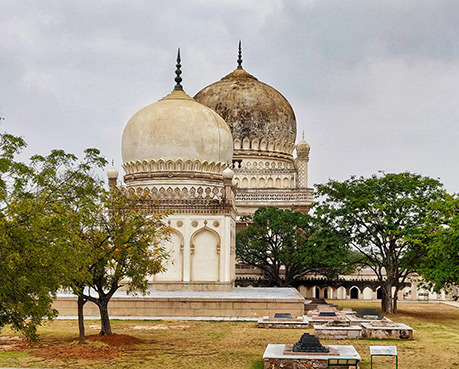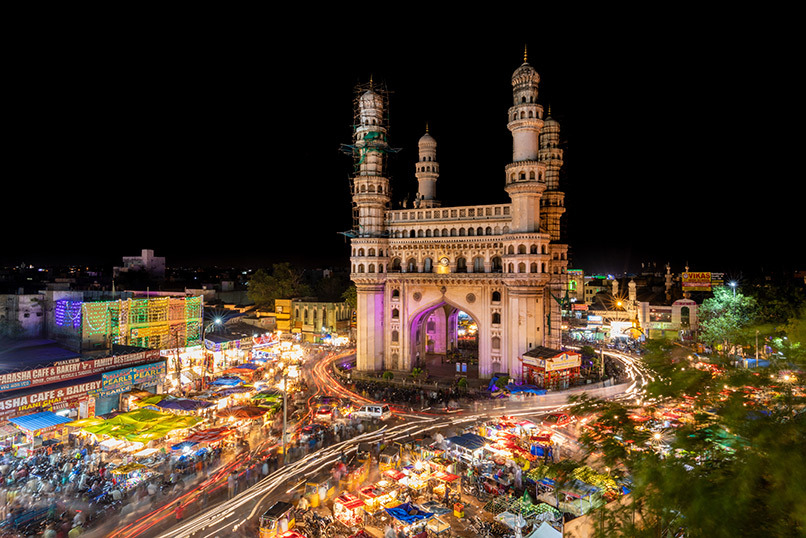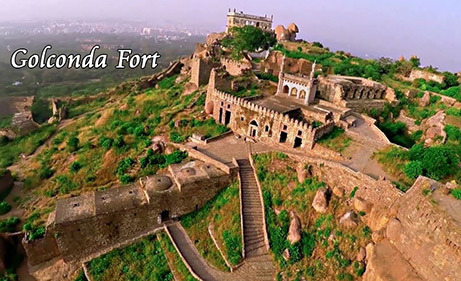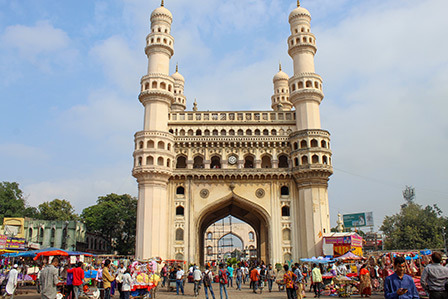INTERESTING FACT: One of the many theories states that Charminar was built to commemorate victory over Cholera, which was spread across the city at that time.

As soon as the work started for building Charminar, the construction of one of the largest mosques in the country
Mecca Masjid also started, but the latter took around 100 years to complete.
Interestingly the bricks made up of soil from Mecca were used in the central arc of the mosque, which resulted in its name as Mecca Masjid.

Another important place which is worth mentioning is,
Qutb Shahi Tombs, where all the Qutb Shahi rulers were buried. This complex built in 16th and 17th century contains tombs and mosques reflecting Hindu, Persian, Deccan, and Pathan architecture and are of varying sizes with single and double stories.
Watch a video on Qutb Shahi Tombs.
The rapid growth of the city also attracted invaders, which led to the decline of Qutb Shahis and the city lost its glory gradually. But fate could not hold fortune of the city for a long time and it bounced back dazzling in the reigns of Nizams, who remained friendly with the Mughals as well as the British. It was during their time that Hyderabad became one of the richest regions, which had its own currency mint, railways, and postal system. The last and seventh Nizam Mir Osman Ali Khan was listed in the year 1937 as one of the richest person of the world. Hyderabad was considered the largest princely state in India during the regime of Nizams referred to as the Asaf Jahi dynasty. They had seven rulers until the annexure of the princely state to India in 1948.

To get an idea about the expansive lifestyle of Nizams, one must visit
Chowmohalla Palace (built in 1880s), which still reflects their opulence. As the name 'Chow' translates, it has four palaces and was used as the official residence of Nizams and for their ceremonies and accessions.
The Palace is unique in style, architecture, and elegance and exhibits various artefacts and vintage cars.
The treaties with the British made Nizams to pay heavy annual tribute, which also drained huge amount of their funds. However, they got the wisest Prime Minister, Salarjung, who brought many administrative reforms and thus uplifted their economy. He was succeeded by four members to serve the Nizams. They safeguarded the artefacts, and various collections of the Nizam family, which are now exhibited in
Salarjung Museum (established in 1951).

One of the largest museums in the world, it is housed in around 100 years' old Dewan Devdi palace, which was once the residence of the Salarjung family.
Take a look at the collection of rare artefacts at Salarjung museum in this short video.
A visit to this Pearl City will be incomplete without a treat to the mouth-watering local delicacies.
Hyderabadi Biryani is one among them. A kind of single pot rice dish cooked with a variety of meats or vegetables using various herbs and spices, the name of Biryani is synonymous with Hyderabad.

Few more dishes and beverages which are also famous for their traditional way of cooking apart from their unique taste and worth trying here are Pathar ka gosht, Talawa gosht, Iran Tea and Karachi biscuits.
Take a look at the diverse cuisine of the city of Nizams in this video.
INTERESTING FACT: Hyderabad is famous for its handicrafts, literature, and cuisines, for which it is also listed as a UNESCO creative city of gastronomy.
Dotted with the relics of Qutb Shahi and Nizam rulers, the city emerged as a significant centre of oriental culture. We invite you to come and indulge in the intriguing stories and amazing places to visit when you are here! With us, the itinerary is not just a travel route or a trip. We design, conceptualize and handcraft every journey for you. Our bespoke itineraries and curated experiences in different destinations are what make for those memorable travel moments.


 The mighty fort is known for its brilliant architecture and engineering. To exemplify one such extra ordinary feat is its acoustic system, wherein a sound of clap at the entrance of the fort reaches up to 01 km away to the highest point.
The mighty fort is known for its brilliant architecture and engineering. To exemplify one such extra ordinary feat is its acoustic system, wherein a sound of clap at the entrance of the fort reaches up to 01 km away to the highest point.
 As the city started growing, the fourth sultan Ibrahim Quli Qutb built a manmade lake in 1563 to meet water requirements of the city. The lake fed by the Musi River was designed by Hussain Shah Wali and thus named after him as Hussain Sagar Lake. Spread across 5.7 kms, this beautiful lake adds to the beauty of the city and connects with Secunderabad, which was once a British cantonment. To add charm, the bund on the side of the lake is adorned with a green area. The lightening around the park forms the shape of the Necklace in the evening, which is similar to that of Marine drive of Mumbai.
As the city started growing, the fourth sultan Ibrahim Quli Qutb built a manmade lake in 1563 to meet water requirements of the city. The lake fed by the Musi River was designed by Hussain Shah Wali and thus named after him as Hussain Sagar Lake. Spread across 5.7 kms, this beautiful lake adds to the beauty of the city and connects with Secunderabad, which was once a British cantonment. To add charm, the bund on the side of the lake is adorned with a green area. The lightening around the park forms the shape of the Necklace in the evening, which is similar to that of Marine drive of Mumbai.  The mosque on the topmost floor of four minarets is historically as well as religiously significant. To reach the top of this 56 meters high structure, one needs to climb around 149 winding steps. The prominent landmark of the city is also a site of many religious festival celebrations.
The mosque on the topmost floor of four minarets is historically as well as religiously significant. To reach the top of this 56 meters high structure, one needs to climb around 149 winding steps. The prominent landmark of the city is also a site of many religious festival celebrations.
 As soon as the work started for building Charminar, the construction of one of the largest mosques in the country Mecca Masjid also started, but the latter took around 100 years to complete.
As soon as the work started for building Charminar, the construction of one of the largest mosques in the country Mecca Masjid also started, but the latter took around 100 years to complete.
 Another important place which is worth mentioning is, Qutb Shahi Tombs, where all the Qutb Shahi rulers were buried. This complex built in 16th and 17th century contains tombs and mosques reflecting Hindu, Persian, Deccan, and Pathan architecture and are of varying sizes with single and double stories.
Another important place which is worth mentioning is, Qutb Shahi Tombs, where all the Qutb Shahi rulers were buried. This complex built in 16th and 17th century contains tombs and mosques reflecting Hindu, Persian, Deccan, and Pathan architecture and are of varying sizes with single and double stories.
 To get an idea about the expansive lifestyle of Nizams, one must visit Chowmohalla Palace (built in 1880s), which still reflects their opulence. As the name 'Chow' translates, it has four palaces and was used as the official residence of Nizams and for their ceremonies and accessions.
To get an idea about the expansive lifestyle of Nizams, one must visit Chowmohalla Palace (built in 1880s), which still reflects their opulence. As the name 'Chow' translates, it has four palaces and was used as the official residence of Nizams and for their ceremonies and accessions.
 One of the largest museums in the world, it is housed in around 100 years' old Dewan Devdi palace, which was once the residence of the Salarjung family.
One of the largest museums in the world, it is housed in around 100 years' old Dewan Devdi palace, which was once the residence of the Salarjung family.  Few more dishes and beverages which are also famous for their traditional way of cooking apart from their unique taste and worth trying here are Pathar ka gosht, Talawa gosht, Iran Tea and Karachi biscuits.
Few more dishes and beverages which are also famous for their traditional way of cooking apart from their unique taste and worth trying here are Pathar ka gosht, Talawa gosht, Iran Tea and Karachi biscuits.  We can conduct a virtual destination awareness training program for your team or yourself or a virtual tour for your clients. Let us know the destination of your interest along with your convenient date / time and we will be happy to set up a program for you.
We can conduct a virtual destination awareness training program for your team or yourself or a virtual tour for your clients. Let us know the destination of your interest along with your convenient date / time and we will be happy to set up a program for you.
